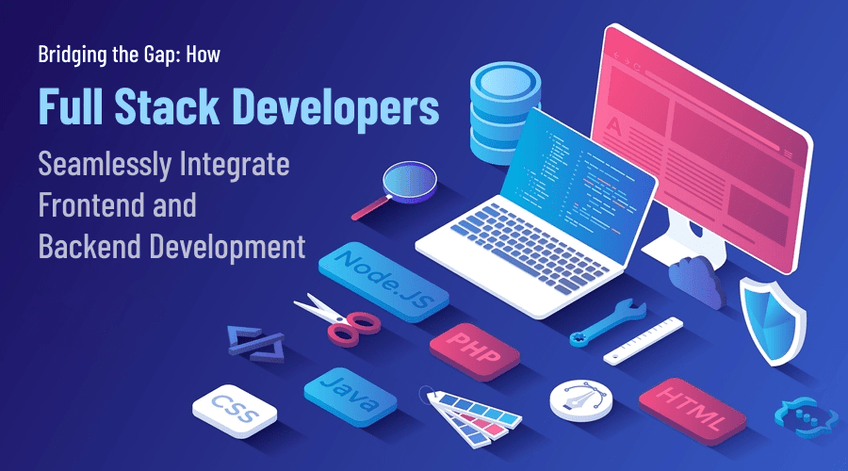In the ever-evolving realm of software development, the collaboration between frontend and backend developers has become indispensable. With the advancement of websites and applications, the demand for flawless integration between these two domains has reached a paramount level.
Enter the full stack developers, the unsung heroes who serve as the vital link between the frontend and backend aspects of a project.
According to a recent LinkedIn report, full stack development ranks among the top ten most sought-after skills worldwide, witnessing an impressive 35% year-over-year surge in job postings. This statistic alone highlights the crucial role played by full stack developers in meeting the demands of modern businesses.

In this captivating blog, we will immerse ourselves in the world of full stack development and unravel the ways in which these versatile professionals bring the best of both worlds together. Prepare yourself for an enlightening journey that will unveil the secrets of seamless frontend-backend integration!
But before we get into that, let's first understand Frontend and Backend Development.
Understanding Frontend and Backend Development
In today's digital landscape, frontend and backend development play vital roles in creating interactive and functional web applications. To appreciate how full stack developers seamlessly integrate these two domains, it is essential to grasp the fundamentals of frontend and backend development.
Frontend development focuses on creating the user-facing aspects of a website or application. This involves designing and implementing intuitive user interfaces using HTML, CSS, and JavaScript.
Frontend developers ensure that the user experience is visually appealing, responsive, and interactive. They collaborate closely with designers to bring wireframes and mockups to life.
Hire skilled frontend developers to enhance your website with stunning user interface.
On the other hand, backend development is responsible for the server-side functionalities that power web applications. Backend developers work with server-side programming languages like Python, Java, or Node.js.
They handle data storage, processing, and communication between the frontend and external systems. Backend development ensures that the application functions smoothly, handles user inputs securely, and communicates with databases and APIs.
While frontend development primarily focuses on the user interface, backend development handles the logic and data processing behind the scenes. Understanding these distinctions is crucial as it sets the stage for comprehending how full stack developers bridge the gap between the two domains.
Read More: Discover the key benefits of hiring a dedicated backend developer
By combining their knowledge of frontend and backend development, full stack developers bring a holistic approach to software development projects. They possess the skills to navigate both realms effectively, enabling seamless integration and cohesive user experiences.
In the following sections, we will explore the specific responsibilities and techniques employed by full stack developers to achieve this perfect synergy.
The Role, Skills and Advantages of Full Stack Developers
In the rapidly evolving landscape of software development, full stack developers have emerged as dynamic and versatile professionals capable of seamlessly handling both frontend and backend responsibilities. Picture this: they possess the skills in HTML, CSS, and JavaScript (front end), as well as Python, Java, or C++ (back end).
Full stack developers are well-versed with a wide range of programming languages, frameworks, and technologies. They have the ability to seamlessly navigate between frontend and backend development, enabling them to contribute at every stage of the software development lifecycle.
However, their role transcends mere technical prowess; they act as bridges, connecting the realms of design, user experience, and functionality. Full stack developers possess a holistic view, comprehending how each intricate piece of an application fits into the grand scheme of things.
With their diverse skill set, full stack developers are well-equipped to tackle a wide range of tasks. From designing captivating user interfaces and implementing cutting-edge frontend functionality, to crafting robust server-side logic and seamlessly integrating APIs, they excel. Moreover, they possess exceptional communication skills, allowing them to effectively engage both technical and non-technical stakeholders.
Skills and Knowledge Required
The technical and soft skills of a full stack developer play a crucial role in their ability to excel in their field. The skills and knowledge required for a full stack developer can vary based on the specific technologies employed in a project.
However, certain fundamental skills and knowledge are indispensable for all full stack developers. These include:
- Programming languages: Mastery in HTML, CSS, JavaScript, Python, Java, C++
- Databases: Proficiency in working with MySQL, PostgreSQL, Oracle
- Web development frameworks: Expertise in frameworks like Django, Rails, Express
- Version control systems: Familiarity with Git, Mercurial
- Methodology: Agile development
- Soft skills: Excellent communication, strong teamwork, and effective problem-solving abilities
Benefits of Hiring Full Stack Developers
The decision to hire full stack developers comes with numerous advantages. Let's explore:
- Cost Savings: By eliminating the need to hire separate developers for frontend and backend roles, you can save valuable resources.
- Enhanced Efficiency: Full stack developers possess a profound understanding of how different elements of an application harmonize, enabling them to work swiftly and efficiently.
- Unleashing Creativity: With a wide range of technologies at their disposal, full stack developers can bring fresh perspectives and innovative solutions to the table, unrestricted by the boundaries of a single tech stack.
- Streamlined Workforce: when you hire dedicated developer it reduces the necessity of multiple developers, saving both time and money. Their expertise enables them to create innovative and user-friendly applications that align with the needs and expectations of your target audience.
- Effective Collaboration: Full stack developers excel in facilitating effective communication and collaboration within your team, fostering better coordination and increased productivity.
- Technological Edge: By staying abreast of the latest advancements, full stack developers can integrate cutting-edge solutions into your projects, ensuring that your applications remain up-to-date and competitive.
The value of full stack developers in any team cannot be overstated. If you seek a developer who can help you construct an exceptional web application, then look no further. A full stack developer is the ideal choice to unlock the full potential of your project.
Bridging the Gap: How Full Stack Developers Integrate Frontend and Backend
Full stack developers possess the unique ability to seamlessly integrate both sides of an application, ensuring a cohesive and engaging user experience.
Here are some ways in which full stack developers integrate frontend and backend development:
Comprehensive Understanding of Frontend and Backend Technologies
Full stack developers possess proficiency in frontend technologies like HTML, CSS, and JavaScript, which are responsible for building user interfaces and client-side functionality.
Moreover, they have in-depth knowledge of backend technologies, including server-side programming languages (e.g., Python, Ruby, or Node.js), frameworks (e.g., Django, Ruby on Rails, or Express.js), and databases (e.g., MySQL or MongoDB).
Designing the Application Architecture
When it comes to application architecture, full stack developers take charge. They are responsible for designing an architecture that considers both the frontend and backend components.
This involves determining how different layers of the application interact with one another and ensuring smooth data flow between them.
Development of APIs
Full stack developers create Application Programming Interfaces (APIs) to facilitate the integration of frontend and backend systems. APIs establish the rules and protocols for communication between these components.
By exposing specific endpoints, APIs allow the frontend to request data or execute actions on the backend, enabling seamless interaction between the two.
User Interface Development
Working with HTML, CSS, and JavaScript frameworks such as React, Angular, or Vue.js, full stack developers build user interfaces. Leveraging their frontend skills, they create visually appealing and user-friendly interfaces that seamlessly interact with the backend.
Implementation of Business Logic and Data Processing
On the backend, full stack developers write server-side code to implement the business logic and handle data processing.
They ensure that the backend systems perform the necessary computations, data storage, retrieval, and manipulation required by the application. This could involve tasks like authentication, data validation, and database querying.
Data Management and Storage
Full stack developers take care of data management, including storing and retrieving data from databases. They design the database schema and write queries to interact with the database system.
Moreover, they implement techniques to optimize data retrieval and storage, improving the overall performance of the application.
Testing and Debugging
Thorough testing of both frontend and backend components falls under the responsibility of full stack developers. They diligently identify and resolve any issues, bugs, or inconsistencies within the application.
This includes testing the user interface, API endpoints, and overall functionality to ensure a smooth user experience.
Deployment and Continuous Integration
Full stack developers are accountable for deploying the application to production environments. This involves setting up servers, configuring the necessary infrastructure, and ensuring accessibility for users.
Additionally, they may implement continuous integration and deployment practices to automate the deployment process and enhance efficiency.
Collaboration and Communication
Full stack developers frequently collaborate with various team members, such as frontend developers, backend developers, designers, and project managers.
Effective communication and collaboration skills are vital in ensuring a seamless integration of frontend and backend components, promoting a cohesive development process.
Tools and Technologies for Full Stack Development
Full stack developers rely on a diverse set of tools and technologies to seamlessly integrate frontend and backend development. These tools enable them to efficiently manage different aspects of the development process and enhance productivity.
Here are some of the essential full stack development technologies:
Frontend Development Tools and Frameworks
- HTML: HyperText Markup Language serves as the foundation for web pages, defining their structure and content.
- CSS: Cascading Style Sheets is used to style web page elements, controlling the appearance of text, images, and other components.
- JavaScript: A programming language that enables the addition of interactivity to web pages, creating animations, games, and interactive elements.
- Bootstrap: A well-known front-end framework offering pre-built components and styles, facilitating the creation of responsive web pages.
- AngularJS: A JavaScript framework designed for building single-page applications, which load all content in a single HTML page, enhancing responsiveness and speed.
- React: A JavaScript library utilized for constructing user interfaces, renowned for its performance and ease of reuse.
- Vue.js: A JavaScript framework similar to React, favored for its simplicity and seamless integration with other libraries and frameworks.
Backend Development Tools and Frameworks
- Python: A versatile programming language commonly employed for back-end development, notable for its readability and extensive library of third-party modules.
- Java: A widely-used general-purpose programming language also prevalent in back-end development, renowned for its portability and robustness.
- Ruby: A general-purpose programming language gaining popularity in back-end development, valued for its simplicity and expressiveness.
- Node.js: A JavaScript runtime environment frequently utilized for building back-end applications, known for its speed and scalability.
- Express.js: A popular web framework for Node.js, simplifying the development of fast and scalable web applications.
- Django: A well-regarded web framework for Python, esteemed for its user-friendly nature and powerful features.
- Ruby on Rails: A renowned web framework for Ruby, distinguished by its simplicity and speed.
Integrated Development Environments (IDEs)
- Visual Studio Code: A widely-used IDE for web development, freely available and open source, offering extensive support for various programming languages and frameworks.
- Sublime Text: Another popular IDE for web development, although it requires a paid license, valued for its speed and powerful features.
- Atom: A free and open source IDE gaining popularity in web development, notable for its flexibility and customizability.
By utilizing the top full stack developer tools and technologies, programmers can streamline the development process, enhance productivity, and achieve seamless integration between frontend and backend components.
Best Practices for Full Stack Development Integration
To ensure a successful integration of frontend and backend development, full stack developers adhere to several best practices. These practices promote efficient collaboration, code organization, and maintainability.
Here are some key best practices for full stack development integration:
Select the appropriate technology stack
A technology stack consists of programming languages, frameworks, and databases used for application development. It is essential to choose a technology stack that aligns well with the requirements of your project.
Utilize version control
Version control is a development practice that enables you to track changes made to your code. Given the nature of full stack development, where both front-end and back-end work is involved, utilizing version control is crucial for maintaining code integrity and facilitating collaboration.
Write clean and maintainable code
Clean and maintainable code is vital for enhancing readability, understanding, and ease of modification. By prioritizing clean code practices, you can streamline the development and maintenance of your application.
Test rigorously
Testing plays a pivotal role in the software development process. It is essential to regularly test your code to ensure its proper functionality. Robust testing practices contribute to the stability and reliability of your application.
Implement agile development methodologies
Agile methodologies offer an efficient and rapid approach to software development. Their iterative nature is particularly advantageous for full stack development, allowing you to quickly iterate on your application and gather early user feedback.
Adhering to these best practices enables full stack developers to integrate frontend and backend development seamlessly.
Challenges and Considerations
While full stack development offers numerous benefits, it also comes with its fair share of challenges and considerations. Full stack developers must navigate these hurdles to ensure successful integration and deliver high-quality applications.
Here are some of the key challenges in full stack development:
Managing Complexity and Scope
Integrating both frontend and backend development introduces increased complexity and a broader scope of work. Full stack developers must effectively manage the intricacies that arise from handling multiple technologies, frameworks, and libraries.
They need to strike a balance between maintaining a deep understanding of both domains while ensuring efficient collaboration and communication between frontend and backend teams.
Keeping Up with Evolving Technologies
The field of software development is ever-evolving, with new frameworks, libraries, and tools emerging regularly. Full stack developers must stay up to date with the latest trends and advancements in both frontend and backend technologies.
It requires continuous learning and adaptability to ensure they are using the most efficient and effective solutions for their projects.
Balancing Depth of Knowledge in Frontend and Backend
Being proficient in both frontend and backend development requires a broad range of skills. However, full stack developers may find it challenging to maintain an in-depth understanding of all the intricacies within each domain.
It is crucial to strike a balance between acquiring a solid foundation in both areas and leveraging the expertise of specialized developers when necessary. Collaboration with frontend and backend specialists can help fill any knowledge gaps and ensure the delivery of optimal solutions.
Project and Resource Management
Full stack developers often work on projects that involve multiple aspects of development simultaneously. This requires effective project management skills to prioritize tasks, allocate resources, and meet deadlines.
They must possess strong organizational abilities to handle both frontend and backend requirements, coordinate with team members, and ensure smooth project execution.
By acknowledging and addressing these challenges, full stack developers can overcome obstacles and deliver successful outcomes.
Their ability to adapt, learn, collaborate, and manage projects effectively contributes to the seamless integration of frontend and backend development.
Why Hire Full Stack Developers From ThinkODC?
When it comes to achieving successful integration in full stack development, it's crucial to hire skilled and experienced developers. At ThinkODC, we have a team of full stack developers who possess the necessary skills and expertise to deliver top-notch applications.
Our developers have a deep understanding of both frontend and backend development, allowing them to seamlessly combine both aspects. They are equipped with the latest tools and technologies and keep up with the latest advancements in the industry.
Moreover, our developers excel in project management and communication, ensuring efficient collaboration and smooth execution of projects.
By partnering with ThinkODC's full stack developers, you gain a unique advantage in achieving successful integration in full stack development. This leads to high-performing and user-friendly applications.
Conclusion
In today's dynamic software development landscape, full stack developers play a vital role in bridging the gap between frontend and backend development. By seamlessly integrating both domains, they ensure the creation of cohesive and functional applications. Understanding the fundamentals of frontend and backend development is crucial to appreciate the versatility of full stack developers.
By leveraging their comprehensive skill set, full stack developers effectively communicate between teams, employ a holistic development approach, and leverage tools and technologies to streamline integration. They adhere to the best practices, overcome challenges, and ensure efficient project and resource management.



